Honeywell XS100 Handleiding
Honeywell
Rookmelder
XS100
Bekijk gratis de handleiding van Honeywell XS100 (2 pagina’s), behorend tot de categorie Rookmelder. Deze gids werd als nuttig beoordeeld door 204 mensen en kreeg gemiddeld 5.0 sterren uit 102.5 reviews. Heb je een vraag over Honeywell XS100 of wil je andere gebruikers van dit product iets vragen? Stel een vraag
Pagina 1/2

Thank you for purchasing this Honeywell re alarm.
The alarm is suitable for use in domestic premises (including static
holiday homes) and leisure accommodation vehicles (LAVs)
This manual contains important safety information about the
installation and operation of the alarm. Please read the manual
carefully and keep it in a safe place for future reference. Please
also explain the alarm operation to all other occupants of the
building.
You are advised to have a Fire evacuation plan, which you should
test every month. Everyone in the building should be familiar with
the alarm signals, so that they react to them without delay.
Honeywell offers three models of its battery powered re alarms:
XH100 is a heat alarm approved to BS5446-2:2003.
XS100 is an optical smoke alarm approved to EN14604:2005 and
uses an optical detection technique only.
XS100T is a optical-thermal smoke alarm approved to
EN14604:2005, which uses dual detection techniques for quicker
response times, wider range of re types and fewer false alarms.
All have a sealed-in battery with a 10-year lifetime and warranty.
They have clear visible status indications for Power (green), Fault
(yellow) and three extra-large Alarm indicators (red).
In addition, all versions have an audible alarm and a TEST/HUSH
button.
2. Description1. Welcome
Operating and
Installation Instructions
X-Series Battery Powered Fire Alarms
XS100T Optical-thermal smoke alarm
XS100 Optical smoke alarm
XH100 Heat alarm
Warnings
To avoid dust and debris contamination, the smoke alarm should be
removed from the mounting for the duration of any building work
involving dust or debris. If this is not possible then the alarm vents must
be fully covered with a plastic bag or tape whilst the work is in progress.
While covered, the alarm will not detect fires or smoke, so it is vital the
covering is removed when work is completed each day, and replaced the
following day if necessary.
The alarm is permanently sealed for safety, so do not attempt to open it.
3. Fire Alarm Operation continued
3. Fire Alarm Operation
*Note: There is an option to disable the ashing power light during
initial setup e.g. for installation in bedrooms. Please see the
installation instructions for further details.
The CE mark afxed to this product
conrms its compliance with the
European Directives which apply
to the product and, in particular, its
compliance with the harmonised specications of standard EN
14604 relating to Construction Products Directive 89/106/EEC.
The NF – Smoke Alarm Devices mark provides assurance as to
safety and consistent quality inspected by experts.
Through its rigorous and exhaustive inspections (holder’s quality
management system, product inspections, audits and monitoring
tests, etc.), the NF mark represents a comprehensive guarantee
for consumers that the certied products are compliant.
The NF - Smoke Alarm Devices mark conrms the product’s
compliance with certication rules NF 292.
If there are other alarms connected to it in a network, they will
ash and chirp every four hours to show that an alarm somewhere
in the network has a fault, and that it needs to be investigated.
Once the alarm in the fault state is located, counting the number
of chirps and ashes will establish whether it is a wireless module
fault or a smoke alarm fault.
The chirps can be silenced for 24 hours by pressing the
TEST/HUSH button until the yellow LED blinks. Pressing the button
again will restore the chirps. The 24 hour period can be restarted
by pressing the button twice. When a remote fault TEST/HUSH
occurs, press the button on the alarm that is in the TEST/HUSH
fault state as that will hush the other alarms in the network.
You must investigate and clear all faults without delay. When you
nd the faulty alarm:
• Check the ‘Replace by...’ date, and replace the alarm if it
has expired.
• Check the dates on all of the other alarm modules if one
module has passed its ‘Replace by...’ date.
Note: The fault signal could be caused by a low battery, or an
electronics failure, or by dust entering the unit and obstructing the
optical sensor.
A replace by date is also printed on the side of the unit to facilitate
an advance replacement before the end-of-life signal is given. This
date includes a 6 months shelf life, i.e. this is the latest date the
unit should be replaced.
1 2 3
5 6 7 8
13 14 15 16
Status Lights and Sound Meaning
Alarm
(Red)
Power
(Green)
Fault
(Yellow)
Sound
NORMAL
OPERATION*
Normal operation
No smoke and/or heat present
Flashes once every minute. *NB light can be switched off (see installation section)
ALARM
Smoke and/or heat detected
3 chirps and ashes continuously for 60 minutes. Pattern is then repeated once every 30 seconds.
REMOTE FIRE
ALARM or REMOTE
CARBON
MONOXIDE
ALARM**
Fire detected by an interconnected re alarm or Carbon monoxide leak
detected by an interconnected Carbon Monoxide alarm
Fire ALARM: 3 chirps continuously / Carbon Monoxide ALARM: 4 chirps continuously. This alarm will be broadcasted on the
network
REMOTE FAULT**
A wireless connected unit is in fault
Networked units – 4 chirps and 4 ashes every 4 hours. The fault will be broadcasted on the network
WIRELESS MODULE
FAULT**
*The wireless module is not working correctly. Refer to the wireless module
manual for further details
Unit with the fault – 3 chirps and 3 ashes every minute. This fault will not be broadcasted on the network
FAULT
*The unit has reached its end of life and must be replaced
1 chirp and 1 ash every minute
www.homesafety.honeywell.com
www.honeywellanalytics.com
www.honeywell.com
France Customer Service Centre:
Honeywell Environmental Controls
ZI de Borly
72, chemin de la Noue
74380 Cranves Sales
France
Tel: 08 10 59 60 63
www.honeywell-confort.com
Acts for and on behalf of Life Safety Distribution AG,
Javastrasse 2, 8604 Hegnau, Switzerland by
its Authorised Representative Honeywell Inc.
Please Note:
While every effort has been made to ensure
accuracy in this publication, no responsibility
can be accepted for errors or omissions. Data
may change, as well as legislation, and you
are strongly advised to obtain copies of the
most recently issued regulations, standards,
and guidelines. This publication is not intended
to form the basis of a contract. Please retain
product documentation for the lifetime of
the product.
xxx-xxxx-xxx
MAN0982_Issue 1_01/15_EN
© 2015 Honeywell Analytics
Big, easy to press button
• Fault Hush
• Alarm Hush
• Test with reduced
sound level
Clean front and user interface
• Indicators are only visible when used
Rounded shape gives
alarm a low visible prole
Separate, labelled indicators
for each power state
• Power
• Fault (e.g End of life)
Clear and big alarm indicators
• Visible from all sides
All alarms have three (four, if equipped with wireless module)
status indicators and a TEST/HUSH button.
The green POWER light indicates that the unit is activated and
working normally.
The red light indicates that a re has been detected.ALARM
The yellow FAULT light indicates that the unit is not working
properly.
The TEST/HUSH button is used to test the unit, or to mute an
alarm or fault signal.
Normal operation
The green POWER light will ash once per minute, to indicate
that your alarm is working*.
Power Fault Alarm
Contact us
*unless the light is switched off during installation
**only applicable when a wireless connection plug-in module is installed
***unless muted by pressing the TEST/HUSH button
Alarm
If a re is detected, the red indicators will ash and ALARM
the loud audible alarm will sound continuously. You should
immediately evacuate the premises and then contact the
emergency services. (Do not pause to collect property or to ring
for help.)
However, if you are certain that it is a false alarm caused by
steam, cooking fumes or burnt toast; you can press the
TEST/HUSH button to silence the alarm for 5 minutes while the
air clears.
Caution: If you cannot reach the alarm from oor level, use a
broom handle (or similar) to press the test button. Please do not
climb on anything to help you reach.
Each re alarm has a dot on its side indicating which type of alarm
it is.
Optical-thermal
smoke alarm Heat alarm Optical
smoke alarm
• • • • • •
All Honeywell X-Series alarms (including optional X-Series Carbon
Monoxide alarms) can be wirelessly interconnected using an
optional plug-in module. This means that if one X-Series Alarm
triggers an alarm, all interconnected units will give a loud audible
alarm (85dB) as well. This is especially useful, when living in a
large or multi-story dwelling. Some wireless module information
is included in this manual for completeness. If equipped, the
module will use the indicator for Wireless (blue) on the Fire Alarms.
5. Testing your alarm
Test/Measuring mode overview:
Press the
button for
1 s 2 s 3 s 4 s 5 s 6s 7s 8s 9s 10s 11s 12s 13s 14s 15s 16s 17s 18+s
Unit mode Green Flash
+ chirp
Yellow Flash
+ chirp
Red Flash
+ chirp
Reduced volume alarm
pattern
Pause High volume alarm pattern Pause Remote Test* (see
‘Monthly Test with
Wireless Function
note below)
Done even if button released Will go back to Normal mode as soon as button released Button may be
released
Automatic self-test
Your re alarm has a self-test function, which is performed
automatically every 10 seconds.
Monthly Test
The re alarm should be tested monthly to check that all visual and
audible signals are working.
Press the TEST/HUSH button for 1 second to activate a full test
cycle showing all lights/messages (green, yellow, red) and sound
with the audible output at a reduced level
Hold the TEST/HUSH button for 10 seconds or more if you want to
test the full 85dB sound level.
Caution: If you cannot reach the alarm from oor level, use a
broom handle (or similar) to press the test button. Please do not
climb on anything to help you reach.
Monthly Test with Wireless Function
To test your wireless alarm communication, press the test/hush
button on one alarm and keep it pressed. Once the alarm has
completed its full volume alarm test, it enters a Remote Test state
comprising one red LED ash with a chirp every 6 seconds. This
is repeated by all interconnected alarms, enabling each connected
alarm to be checked at the same time. Pressing the test/hush
button again returns the alarms back to the Normal Condition.
Alternatively, the alarms will return to a normal condition after 10
minutes if the test/hush button isn’t pressed.
For more information, refer to the Wireless Module manual.
Essential certied features covered by the NF mark
NF EN 14604: 2005 Dispositif d’alarme de fume / Smoke Alarm Devices
Type of
mounting
Wall only YES NO
Ceiling only YES NO
Wall or ceiling YES NO
Battery duration of the main power supply 1 year 5 years 10 years
Interconnectable device YES NO wire radio
Suitable for installation in a mobile home YES NO
Connection to external ancillary devices YES NO
Radio link YES NO
Central alarm system Other
Individual alarm indicator YES NO
Alarm silence facility YES NO
Accessibility Option YES NO
Certication Body
AFNOR Certication, 11, rue Francis de Pressensé, F-93571 La Plaine Saint-Denis Cedex
Telephone: +33(0)1 41 62 80 00 Fax: +33 (0)1 49 17 90 00 E-mail: certication@afnor.org
Websites: www.afnor.org and www.marque-nf.com
Note: The Alarm
HUSH
function will silence the alarm for 5 minutes
after which the alarm will return to full sensitivity. The Alarm
HUSH
function can be operated repeatedly if required.
Faults
If the unit is in FAULT YELLOW the light will ash every minute
with one short chirp. (The only exception is a wireless module fault,
which is signalled with 3 chirps. In this case, refer to the wireless
module manual for further details).
The re alarms do not require any maintenance other than to
clean the outside case occasionally with a damp cloth and mild
detergent.
For the smoke alarms (XS100T, XS100) ensure that the openings
on the side of the unit are not blocked with dust or dirt.
Dust and insect contamination can inhibit the operation of the
smoke alarm. Use a vacuum cleaner to ensure that it is kept
clean and free of dust and other contamination.
Warning: Do not paint the detector
4. Precautions during use
DAAF
www.marque-nf.co m
0333--RSA002 (15)
This package contains:
Either an optical smoke alarm (XS100), an optical-thermo
alarm (XS100T) device or a heat alarm (XH100), which uses
the light scattering or transmitting principle.
Absence of radioactive substances.
Delivered with a battery
Installation recommendations with screws and wall plugs
Ergonomics validated to limit the risks of incorrect use
(battery “forgotten”, battery inserted incorrectly, etc.)
Product’s marking and documentation in French
Product delivered with clear and explicit installation and
maintenance instructions
Environmental protection: manufacturer’s membership of a
waste management association with its logo
Related service: consumer helpline
PROOF
Please review content carefully and provide feedback
Proof No: 2
Date: 20-01-15
***

Where not to put the Smoke Alarms (XS100T and XS100)
A smoke alarm (XS100T, XS100) should not be installed in
bathrooms or kitchens where steam or cooking fumes could give
rise to false alarms, or in a garage where it could react to exhaust
fumes from your vehicle.
Where not to put the Heat Alarm (XH100)
Heat alarms should not be installed in locations where local
regulations require a Smoke alarm that satises EN14604. Check
with your local re and rescue service if you are unsure.
Mounting the Alarm on a ceiling
The central hole may be used on its own or alternatively if
specic xed orientation is required, the two slots can be used
1. Place mounting plate where you want to mount the alarm.
2. With a pencil, mark the location of the screw holes.
3. Drill either one or two holes 5 mm in diameter and >25 mm
in depth and then insert the provided plastic plugs.
4. Screw the mounting plate to the ceiling using supplied
screws.
Mounting the Alarm on a wall
Sometimes it may be advisable to mount additional alarms on a
wall instead of a ceiling. For example, this might be necessary in
tall vertical spaces such as stairwells, because heat and smoke
may rise rapidly and by-pass the ‘dead air’ areas that can form
beneath stair landings. Also, by visibly ashing above the stairs,
it can warn occupants of danger on a lower oor before they
descend into it.
If you do use this method, the alarm(s) should be placed where
they can be seen from above, and should be well away from any
corners or obstructions.
The procedure for tting the alarm is the same as that used for
ceiling mounting, but you may want to put the locking tab at the
bottom or side where it is more easily accessible.
The alarm is switched off by removing it from the ceiling
mounting plate. To remove the alarm, press on the tamper proof
tab located at the edge of the alarm, and then slide the alarm to
the side to remove it from the mounting plate. If the tamper proof
option has been used, insert a small screwdriver carefully into the
gap and apply slight pressure before sliding the alarm to the side.
13. Switching off the Alarm
8. Installation – Where not to put the alarm
7. Installation – Where to site the alarms
7. Installation – Where to site the alarms continued
18 19 20
21 22 23 24
25 26 27 28
29 30 31 32
This section provides general recommendations for the
location of battery powered re alarms in residential premises.
Please ensure that you also follow country specic regulations
and guidelines such as the British BS5839-6 or the German
DIN14676. For example, certain countries require the installation
of interconnected mains powered re alarms.
The selection of the correct re alarm model depends on the
location it will protect.
Where to install Smoke Alarms (XS100T and XS100)
Ideally a smoke alarm should be installed in every room of a
house, except kitchens, bathrooms and garages. As a minimum,
one smoke alarm should be tted on every level of the house,
including stairways. While the XS100 smoke alarm is sufcient
for this purpose, the XS100T optical-thermal re and smoke
alarm is specially recommended for use on exit routes and
stairways as it has the potential to detect heat build-up in
narrow or high areas where smoke may not reach the alarm.
Where to install Heat Alarms (XH100)
Heat alarms should be installed where smoke alarms can’t go,
as they are not affected by fumes, vapours or condensation. I.e.
they can go in kitchens, bathrooms or garages.
Preferred locations
The alarm should be tted on the ceiling, as close to the centre of
the room as possible but at least 50 cm (10 inches) from any wall
or light tting. This is to avoid dead air in the
corners of the room where smoke might not
reach, or possible obstruction
by light ttings.
Using alarms in a network
Networked alarms can give advance warning of potential danger
from hidden res. They operate as shown below.
The Alarm pack contains:
• 1 x Fire Alarm
• 1 x Ceiling mounting plate
• Plugs and screws
• Instructions (this document)
10. Deactivating the power light ashes 11. First time switch on
Once fully mounted in the mounting plate, the green power
light will ash every minute to show that the batteries are OK.
However, this might be annoying in bedrooms, so you have the
option to stop this happening.
To deactivate the power light ashes, press the TEST/HUSH
button ve times during the rst 30 seconds after pushing the
alarm fully into its mounting. The power light will ash each time
the TEST/HUSH button is pressed. If deactivation is successful,
the green POWER light will ash ve times in conjunction with
short chirps
If you have carefully read all of these instructions and your alarm
still fails to work, contact the nearest customer service centre
listed in the ‘Contact Us’ section. Our Customer Service advisors
may be able to resolve your problem quickly. Alternatively you
can contact your local supplier.
To return the alarm for repair or replacement, please either use
the original packaging or put it in a solid box or padded envelope
with a letter describing the fault. To prevent inadvertent activation
in transit, please switch off the alarm by removing it from the
mounting plate.
Please notify your postal service that the package contains
sealed batteries, as they might be restricted or forbidden postal
items.
Proof of purchase must be provided if you want to claim repair
under the warranty.
The Green Dot logo signies that we are a
member of an organisation which collects and
recycles packaging. Our packaging is widely
recycled using local facilities.
The alarm can be locked via use of a tamper-proof clip on the
mounting plate. This should be removed before installation.
1. Break off the removable clip. Pliers can be used if required.
2. Fix the alarm in place on the ceiling.
3. The alarm can now only be removed (and turned off) by using
a screwdriver
16. Troubleshooting and getting assistance
17. Recyclable packaging
12. For Tamper Proof Ceiling Mounting
First read the paragraph above and decide whether or not you
want the power light to ash.
To switch on the alarm:
1. Fit the alarm onto the ceiling mounting plate approximately
10 mm off centre
2. Press rmly against the mounting plate and slide the alarm
sideways until the locking tab clicks
3. The unit will automatically switch on
The alarm must be xed horizontally and to the ceiling using the
enclosed mounting plate. The mounting plate can be screwed
to the ceiling using either the central hole or the two slots in the
ceiling mounting plate (see diagram).
Fitting the alarm to the plate will switch it on.
Note: In special circumstances an alarm may be mounted on a
wall.
20. Warranty18. End of Life
14. Decorating and Building Work
19. Disclaimer
15. Conformance
Honeywell warrants your new re alarm for ten years from the date
of purchase by the end user or until the expiry date on the side of
the unit, whichever occurs rst, according to the specications as
set out in this instruction manual.
We will, at our discretion, repair or replace, with the same or a
similar product, any part of the re alarm which is found to be
defective in either materials or workmanship within the warranty
period.
We shall be under no obligation to repair or replace units which
are found to be defective in any way due to unreasonable use or
neglect, improper storage, if not used or maintained in accordance
with its user manual, or if the product has been tampered with or
found to have been dismantled (other than as specied in its user
manual).
The warranty supplied with this product does not replace your
statutory rights, but our liability under the warranty is limited to the
price of the faulty product.
In no event are we liable for (a) any direct, indirect, incidental,
consequential loss; (b) any loss arising from business interruption;
(c) loss of prots; (d) loss of revenue; (e) loss of use of any property
or capital; (f) loss of anticipated savings or loss of data due to the
use of this product.
• Raise the alarm by shouting Fire, Fire, Fire, or by banging
metal objects together.
• Get out straight away, using the nearest re exit.
• Do not stop to investigate the re or to collect valuables
or pets.
• Use your escape route to get everyone out and meet at an
agreed point.
• Close any doors which are open, and only open the doors you
need to go through. This will help to stop the re spreading
so rapidly.
• Check doors and handles with the back of your hand. If they
feel warm, don’t open the door as the re is on the other side.
• If there is a lot of smoke, crawl along the oor as the air and
visibility will be better.
• Once you’ve got everyone out of the building, call the Fire
Brigade from any phone. Give the operator your name and
address.
• Don’t go back into the building for anything. If there is still
someone inside, tell reghters when they arrive – they will
be able to nd the person quicker and more safely than you.
• Find somewhere safe to wait for the Fire Brigade. When they
arrive, try to give them as much information as possible about
the re and building.
21. What to do in the case of a re alarm
6. Specication
This product complies with the Waste Electrical and
Electronic Equipment (WEEE) Directive 2002/96/EC.
Components or assemblies bearing this or similar
symbols shall not be treated as household or municipal waste.
Waste electrical products (end of life) shall be recovered and
disposed of at specialist WEEE disposal facilities.
Please contact your local authority, your distributor,
or the manufacturer if you require more information
about recycling WEEE.
You are advised to cover or remove the alarm during decoration
and building work to protect the alarm from inadvertent
operation, damage, or the ingress of dust or debris.
Please ensure that alternative safety arrangements are in place
while the alarm is covered and inoperable, and ensure that
the protection is removed when work has stopped for the day.
Failure to do so could lead to loss of life.
Smoke and Fire alarms are designed to alert you to the presence
of potentially dangerous smoke or re. They are not designed or
intended to remedy a re or to locate or record a specic source of
re. Honeywell shall therefore not be held liable to pay for any re
investigation or service call carried out or arranged in response to
an alarm.
Dust and insect contamination is beyond our control, it is totally
unpredictable and is considered normal wear and tear. For this
reason, contamination is not covered by the warranty.
The XS100 and XS100T have been tested and approved to EN
14604 for compliance with Construction Products Regulations.
The XH100 has been tested and approved to BS 5446-2, re
detection and re alarm devices for dwellings, specication for
heat alarms.
The XS100T, XS100 and XH100 comply with the current EMC
and ROHS directives.
The XW100 radio module complies with the R&TTE directive.
The alarm should be tted where you can hear it when you are
asleep, for example in the hallway outside your bedrooms. This will
also protect you from smoke rising up the stairs from a lower level.
9. Installation – Mounting the Alarm
Clip with a breakable part
Warning
The optional power light de-activation can only be done during
the rst 30 seconds after pushing the alarm fully into the
mounting plate!
Switch on operation
Locking / release
tab (Removable)
Note: National regulations differ with respect to quantity
and placement of smoke detectors. If in doubt, please
check, for example by contacting your local Fire Service.
>70 cm
>50 cm
Optimal Satisfactory
<7.6 m
Reliability
Detection
principle
XS100T: Optical with thermal assistance
XS100: Optical
XH100: Thermal
Approvals XS100T, XS100: CE EN14604:2005/AC:2008
VdS Q-label (vfdb14-01)
NF292
XH100:
BS5446-2:2003
BSI Kitemarked
Other
compliances
RoHS, REACh, R&TTE and EMC
Self-test
function
Every 10 seconds
Lifetime and
warranty
10 years
Operating environment
Temperature -10 °C to 55 °C
Humidity 25-93% Relative Humidity (non-condensing)
IP rating IPX2D
Electrical and interconnection
Power supply Long-life lithium battery, 3V sealed-in
Wireless A separately sold wireless plug-in module
XW100 is available
User interface
Visual
indicator
Power: Green LED
Alarm: 3 large red LEDs
Fault: Yellow LED
Wireless (if installed): Blue LED
Audible >85 dB @ 3 m with distinct re alarm sound
(3 chirps)
Button Test with reduced sound level
Alarm hush
Fault hush (24 hours)
Product
Size Ø 116 mm x 42 mm
Weight 190 g
Packaging
Type Carton Box with Euro-hole hanger
Dimension 119 x 119 x 55 mm
Scope of
supply
Fire alarm including sealed battery
Product specificaties
| Merk: | Honeywell |
| Categorie: | Rookmelder |
| Model: | XS100 |
Heb je hulp nodig?
Als je hulp nodig hebt met Honeywell XS100 stel dan hieronder een vraag en andere gebruikers zullen je antwoorden
Handleiding Rookmelder Honeywell

18 Maart 2023

10 Februari 2023

22 Januari 2023

14 November 2022
Handleiding Rookmelder
- Interlogix
- Calex
- Fito Profi-line
- Grundig
- Hochiki
- Pristine
- Qolsys
- Fito
- TEF
- Malmbergs
- Chacon
- IKEA
- Logilink
- Bavaria
- Inovonics
Nieuwste handleidingen voor Rookmelder

27 Juli 2025
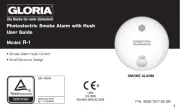
9 Juli 2025
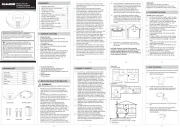
4 Juli 2025
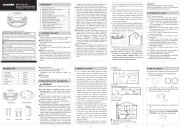
4 Juli 2025

1 Juli 2025
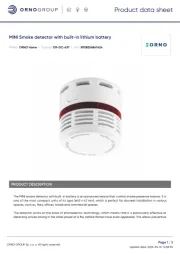
11 Juni 2025
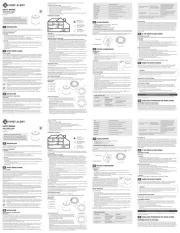
8 Juni 2025
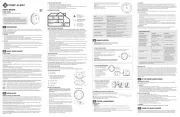
8 Juni 2025
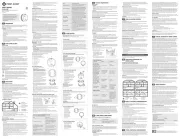
8 Juni 2025

30 Mei 2025